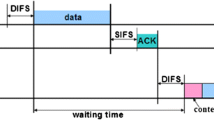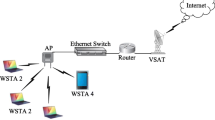Abstract
IEEE 802.11e standard defines two Medium Access Control functions to support Quality of Service (QoS) for wireless local area networks: Enhanced Distributed Channel Access (EDCA) and HCF Controlled Channel Access (HCCA). EDCA provides fair prioritized QoS support while HCCA guarantees parameterized QoS for the traffics with rigid QoS requirements. The latter shows higher QoS provisioning with Constant Bit Rate traffics. However, it does not efficiently cope with the fluctuation of the Variable Bit Rate (VBR) video streams since its reference scheduler generates a schedule based on the mean characteristics of the traffic. Scheduling based on theses characteristics is not always accurate as these traffics show high irregularity over the time. In this paper, we propose an enhancement on the HCCA polling mechanism to address the problem of scheduling pre-recorded VBR video streams. Our approach enhances the polling mechanism by feed-backing the arrival time of the subsequent video frame of the uplink traffic obtained through cross-layering approach. Simulation experiments have been conducted on several publicly available video traces in order to show the efficiency of our mechanism. The simulation results reveal the efficiency of the proposed mechanism in providing less delay and high throughput with conserving medium channel through minimizing the number of Null-Frames caused by wasted polls.
















Similar content being viewed by others
References
Cisco Visual Networking Index. (2013). Global mobile data traffic forecast update, 2012–2017. Cisco white paper, Feb. 6.
IEEE 802.11. (1999). IEEE standard for information technology- telecommunications and information exchange between systems—Local and metropolitan area networks—Specific requirements—Part 11: Wireless LAN Medium Access Control (MAC) and Physical Layer (PHY) Specifications. ANSI/IEEE Std 802.11, 1999 edition (R2003), p. i-513.
Al-Jubari, A. M., Othman, M., Ali, B. M., & Hamid, N. A. W A. (2013). An adaptive delayed acknowledgment strategy to improve TCP performance in multi-hop wireless networks. Wireless Personal Communications, 69(1), 307–333.
Saif, A., & Othman, M. (2013). SRA-MSDU: Enhanced A-MSDU frame aggregation with selective retransmission in 802.11n wireless networks. Journal of Network and Computer Applications, 36(4), 1219–1229.
IEEE 802.11e. (2007). IEEE standard for information technology—Telecommunications and information exchange between systems—Local and metropolitan area networks—Specific requirements—Part 11: Wireless LAN Medium Access Control (MAC) and Physical Layer (PHY) Specifications. IEEE Std 802.11-2007 (Revision of IEEE Std 802.11-1999), pp. 1–1076.
IEEE Standard for Information technology-Telecommunications and information exchange between systems Local and metropolitan area networks-Specific requirements Part 11: Wireless LAN Medium Access Control (MAC) and Physical Layer (PHY) Specifications. IEEE Std 802.11-2012 (Revision of IEEE Std 802.11-2007), pp. 1–2793, March 2012.
Andreadis, A., & Zambon, R. (2012). Improving QoS performance in IEEE 802.11e under heavy traffic loads. International Journal of Wireless Information Networks, 19(1), 49–61.
Shakir, A. A., Ng, C. K., Noordin, N. K., & Ismail, A. (2013). Efficient back-off mechanism for multimedia support in 802.11e EDCA wireless ad-hoc networks. Wireless Personal Communications, 71(1), 439–466.
Pang, W. L., Chieng, D., & Ahmad, N. N. (2013). Adaptive priority sliding admission control and scheduling scheme for DCF and EDCA WLANs. Wireless Personal Communications, 70(1), 295–321.
ITU-T. (1988). ITU-T recommendation G.711. Pulse code modulation (PCM) of voice frequencies.
Sikora, T. (1997). MPEG digital video-coding standards. IEEE Signal Processing Magazine, 14(5), 82–100.
ITU-T. (1996). ITU-T recommendation H.263. Video codec for low bit rate communication.
Jelinek, M., Vaillancourt, T., & Gibbs, J. (2009). G.718: A new embedded speech and audio coding standard with high resilience to error-prone transmission channels. IEEE Communications Magazine, 47(10), 117–123.
Lee, D.-Y., Kim, S.-R., & Lee, C.-W. (2009). An Enhanced EDD QoS Scheduler for IEEE 802.11e WLAN. In T.-h. Kim, L. T. Yang, J. H. Park, A. C.-C. Chang, T. Vasilakos, Y. Zhang, D. Sauveron, X. Wang & Y.-S. Jeong (Eds.), Advances in computational science and engineering, volume 28 of communications in computer and information science (pp. 45–59). Berlin: Springer.
Jansang, A., & Phonphoem, A. (2011). Adjustable TXOP mechanism for supporting video transmission in IEEE 802.11e HCCA. EURASIP Journal on Wireless Communications and Networking, 2011(1), 1–16.
Cecchetti, G., Ruscelli, A. L., Mastropaolo, A., & Lipari, G. (2012). Providing variable TXOP for IEEE 802.11 e HCCA real-time networks. In Wireless communications and networking conference (WCNC), 2012 IEEE, pp. 1508–1513. IEEE.
Al-Maqri, M. A., Othman, M., Ali, B. M., & Hanapi, Z. M. (2015). Adaptive multi-polling scheduler for QoS support of video transmission in IEEE 802.11e WLANs. Telecommunication systems, pp. 1–19. doi:10.1007/s11235-015-0020-y
Fitzek, F. H. P., & Reisslein, M. (2001). MPEG-4 and H.263 video traces for network performance evaluation. Network, IEEE, 15(6), 40–54. Traces available at http://www-tkn.ee.tu-berlin.de/research/trace/trace.html.
Grilo, A., Macedo, M., & Nunes, M. (2003). A scheduling algorithm for QoS support in IEEE802.11 networks. IEEE Wireless Communications, 10(3), 36–43.
Skyrianoglou, D., Passas, N., & Salkintzis, A. K. (2006). ARROW: An efficient traffic scheduling algorithm for IEEE 802.11e HCCA. IEEE Transactions on Wireless Communications, 5(12), 3558–3567.
Huang, J.-J., Chen, Y.-H., & Chang, C.-Y. (2009). An MSI-based scheduler for IEEE 802.11e HCCA. In Vehicular technology conference fall (VTC 2009-Fall), 2009 IEEE 70th, pp. 1–5.
Huang, J.-J., Chen, Y.-H., & Shiung, D. (2010). A four-way-polling QoS scheduler for IEEE 802.11e HCCA. In TENCON 2010–2010 IEEE region 10 conference, pp. 1986–1991, Nov 2010.
Chen, Y.-S., Lee, Y.-W., & Park, J. H. (2011). Enhanced HCCA mechanism for multimedia traffics with QoS supportin IEEE 802.11e networks. Journal of Network and Computer Applications, 34(5), 1566–1571.
Lo, S.-C., Lee, G., & Chen, W.-T. (2003). An efficient multipolling mechanism for IEEE 802.11 wireless LANs. IEEE Transactions on Computers, 52(6), 764–778.
Kim, S., Kim, Y., Choi, S., Jang, K., & Jin-Bong, C. (2005). A high-throughput MAC strategy for next-generation WLANs.
Leu, F.-Y., Kuan, C.-C., & Deng, D.-J. (2005). A QoS provision multipolling mechanism for IEEE 802.11e standard. In 2005 International conference on wireless networks, communications and mobile computing, Vol. 1, pp. 392–397.
Kim, B.-S., Kim, S. W., Fang, Y., & Wong, T. F. (2006). Two-step multipolling MAC protocol for wireless LANs. IEEE Journal on Selected Areas in Communications, 23(6), 1276–1286.
Hsieh, J.-R., Lee, T.-H., & Kuo, Y.-W. (2009). Energy-efficient multi-polling scheme for wireless LANs. IEEE Transactions on Wireless Communications, 8(3), 1532–1541.
Frederick, R., & Jacobson, V. (2003). RTP: A transport protocol for real-time applications. IETF RFC3550.
Cicconetti, C., Lenzini, L., Mingozzi, E., & Stea, G. (2005). A software architecture for simulating IEEE 802.11e HCCA. In IPS-MoMe05: Proceeding from the 3rd workshop on internet performance, simulation, monitoring and measurement, pp. 97–104.
Issariyakul, T., & Hossain, E. (2012). An introduction to network simulator NS2. New York: Springer.
Acknowledgments
This work has been supported by the Malaysian Ministry of Education under the Fundamental Research Grant Scheme FRGS/1/11/SG/UPM/01/1.
Author information
Authors and Affiliations
Corresponding author
Rights and permissions
About this article
Cite this article
Al-Maqri, M.A., Othman, M., Ali, B.M. et al. Feasible HCCA Polling Mechanism for Video Transmission in IEEE 802.11e WLANs. Wireless Pers Commun 85, 899–924 (2015). https://doi.org/10.1007/s11277-015-2816-1
Published:
Issue Date:
DOI: https://doi.org/10.1007/s11277-015-2816-1




